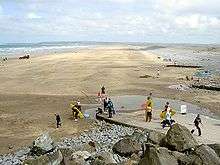Devon
Devon (/ˈdɛvən/, Cornish: Dewnens), also known as Devonshire, is a county of England, reaching from the Bristol Channel in the north to the English Channel in the south. It is part of South West England, bounded by Cornwall to the west, Somerset to the north-east and Dorset to the east. The city of Exeter is the county town. The county includes the districts of East Devon, Mid Devon, North Devon, South Hams, Teignbridge, Torridge and West Devon. Plymouth and Torbay are each geographically part of Devon, but are administered as unitary authorities.[4] Combined as a ceremonial county, Devon's area is 6,707 km2 (2,590 square miles)[5] and its population is about 1.1 million.
Devon derives its name from Dumnonia. During the British Iron Age, Roman Britain and the early Middle Ages, this was the homeland of the Dumnonii Brittonic Celts (the shift from 'M' to 'V' is a typical Celtic consonant shift). The Anglo-Saxon settlement of Britain resulted in the partial assimilation of Dumnonia into the Kingdom of Wessex during the eighth and ninth centuries. The western boundary with Cornwall was set at the River Tamar by King Æthelstan in 936. Devon was later constituted as a shire of the Kingdom of England.
The north and south coasts of Devon each have both cliffs and sandy shores, and the county's bays contain seaside resorts, fishing towns and ports. The inland terrain is rural, generally hilly and has a lower population density than many other parts of England. Dartmoor is the largest open space in southern England, at 954 km2 (368 square miles);[6] its moorland extends across a large expanse of granite bedrock. To the north of Dartmoor are the Culm Measures and Exmoor. In the valleys and lowlands of south and east Devon the soil is more fertile, drained by rivers including the Exe, the Culm, the Teign, the Dart and the Otter.
As well as agriculture, much of the economy of Devon is based on tourism. The comparatively mild climate, coastline and landscape make Devon a destination for recreation and leisure in England. Visitors are particularly attracted to the Dartmoor and Exmoor national parks; its coasts, including the resort towns along the south coast known collectively as the English Riviera; the Jurassic Coast and North Devon's UNESCO Biosphere Reserve; and the countryside including the Cornwall and West Devon Mining Landscape.
History
Toponymy
The name Devon derives from the name of the Britons who inhabited the southwestern peninsula of Britain at the time of the Roman conquest of Britain known as the Dumnonii, thought to mean "deep valley dwellers" from proto Celtic *dubnos 'deep'. In the Brittonic, Devon is known as Welsh: Dyfnaint, Breton: Devnent and Cornish: Dewnens, each meaning "deep valleys." (For an account of Celtic Dumnonia, see the separate article.) Among the most common Devon placenames is -combe which derives from Brittonic cwm meaning 'valley' usually prefixed by the name of the possessor.
William Camden, in his 1607 edition of Britannia, described Devon as being one part of an older, wider country that once included Cornwall:
THAT region which, according to the Geographers, is the first of all Britaine, and, growing straiter still and narrower, shooteth out farthest into the West, [...] was in antient time inhabited by those Britans whom Solinus called Dumnonii, Ptolomee Damnonii [...] For their habitation all over this Countrey is somewhat low and in valleys, which manner of dwelling is called in the British tongue Dan-munith, in which sense also the Province next adjoyning in like respect is at this day named by the Britans Duffneit, that is to say, Low valleys. [...] But the Country of this nation is at this day divided into two parts, knowen by later names of Cornwall and Denshire, [...]
— William Camden, Britannia.[7]
The term "Devon" is normally used for everyday purposes, e.g. "Devon County Council" but "Devonshire" continues to be used in the names of the "Devonshire and Dorset Regiment" (until 2007) and "The Devonshire Association". One erroneous theory is that the "shire" suffix is due to a mistake in the making of the original letters patent for the Duke of Devonshire, resident in Derbyshire. However, there are references to "Defenascire" in Anglo-Saxon texts from before 1000 AD (this would mean "Shire of the Devonians"),[8] which translates to modern English as "Devonshire". The term Devonshire may have originated around the 8th century, when it changed from Dumnonia (Latin) to Defenascir.[9]
Human occupation
Kents Cavern in Torquay had produced human remains from 30–40,000 years ago. Dartmoor is thought to have been occupied by Mesolithic hunter-gatherer peoples from about 6000 BC. The Romans held the area under military occupation for around 350 years. Later, the area began to experience Saxon incursions from the east around 600 AD, firstly as small bands of settlers along the coasts of Lyme Bay and southern estuaries and later as more organised bands pushing in from the east. Devon became a frontier between Brittonic and Anglo-Saxon Wessex, and it was largely absorbed into Wessex by the mid 9th century. A genetic study carried out by the University of Oxford & University College London discovered separate genetic groups in Cornwall and Devon, not only were there differences on either side of the Tamar, with a division almost exactly along the modern county boundary dating back to the 6th Century[10] but also between Devon and the rest of Southern England, and similarities with the modern northern France, including Brittany. This suggests the Anglo-Saxon migration into Devon was limited rather than a mass movement of people.[11][12]
The border with Cornwall was set by King Æthelstan on the east bank of the River Tamar in 936 AD. Danish raids also occurred sporadically along many coastal parts of Devon between around 800AD and just before the time of the Norman conquest, including the silver mint at Hlidaforda Lydford in 997 and Taintona (a settlement on the Teign estuary) in 1001.[13]
Devon was the home of a number of anticlerical movements in the Later Middle Ages. For example, the Order of Brothelyngham—a fake monastic order of 1348—regularly rode through Exeter, kidnapping both religious and laymen, and extorting money from them as ransom.[14]
Devon has also featured in most of the civil conflicts in England since the Norman conquest, including the Wars of the Roses, Perkin Warbeck's rising in 1497, the Prayer Book Rebellion of 1549, and the English Civil War. The arrival of William of Orange to launch the Glorious Revolution of 1688 took place at Brixham.
Devon has produced tin, copper and other metals from ancient times. Devon's tin miners enjoyed a substantial degree of independence through Devon's Stannary Convocation, which dates back to the 12th century. The last recorded sitting was in 1748.[15]
Economy and industry
Like neighbouring Cornwall to the west, historically Devon has been disadvantaged economically compared to other parts of Southern England, owing to the decline of a number of core industries, notably fishing, mining and farming. Agriculture has been an important industry in Devon since the 19th century. The 2001 UK foot and mouth crisis harmed the farming community severely.[16] Since then some parts of the agricultural industry have begun to diversify and recover, with a strong local food sector and many artisan producers. Nonetheless in 2015 the dairy industry was still suffering from the low prices offered for wholesale milk by major dairies and especially large supermarket chains.[17]
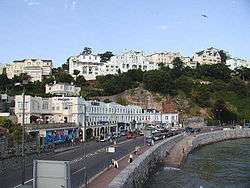
The attractive lifestyle of the area is drawing in new industries which are not heavily dependent upon geographical location;[18][19] Dartmoor, for instance, has recently seen a significant rise in the percentage of its inhabitants involved in the financial services sector. The Met Office, the UK's national and international weather service, moved to Exeter in 2003. Plymouth hosts the head office and first ever store of The Range, the only major national retail chain headquartered in Devon.
Since the rise of seaside resorts with the arrival of the railways in the 19th century, Devon's economy has been heavily reliant on tourism. The county's economy followed the declining trend of British seaside resorts since the mid-20th century, but with some recent revival and regeneration of its resorts, particularly focused around camping; sports such as surfing, cycling, sailing and heritage. This revival has been aided by the designation of much of Devon's countryside and coastline as the Dartmoor and Exmoor national parks, and the Jurassic Coast and Cornwall and West Devon Mining Landscape World Heritage Sites. In 2004 the county's tourist revenue was £1.2 billion.[20] More successful visitor attractions are particularly concentrated on food and drink, including sea-view restaurants in North-West Devon (such as one example belonging to Damien Hurst), walking the South West Coast Path, cycling on the Devon Coast to Coast cycle route and other cycle routes such as the Tarka Trail and the Stover Trail; watersports; surfing; indoor and outdoor folk music festivals across the county and sailing in the 5-mile (8.0 km) hill-surrounded inlet (ria) at Salcombe.
Incomes vary significantly and the average is bolstered by a high proportion of affluent retired people from across Europe's major cities, particularly from the rest of England. Incomes in much of the South Hams and in villages surrounding Exeter and Plymouth are above the national average. The claimant count of the unemployed and people receiving very low incomes is close to the national average of 4.5% in Torbay, Plymouth and Exeter. Their exurbs and rural villages contribute to low unemployment in the administrative county as shown below.
The table also shows the population change in the ten years to the 2011 census by subdivision. It also shows the proportion of residents in each district reliant upon lowest income and/or joblessness benefits, the national average proportion of which was 4.5% as at August 2012, the year for which latest datasets have been published. It can be seen that the most populous district of Devon is East Devon but only if excluding Torbay which has marginally more residents and Plymouth which has approximately double the number of residents of either of these. West Devon has the fewest residents, having 63,839 at the time of the census.
| Unit | JSA or Inc. Supp. claimants (August 2012) % of 2011 population | JSA and Income Support claimants (August 2001) % of 2001 population | Population (April 2011) | Population (April 2001) |
|---|---|---|---|---|
| Devon | 2.7% | 6.6% | 746,399 | 704,493 |
| Ranked by district | ||||
| Exeter | 3.5% | 7.5% | 117,773 | 111,076 |
| Torridge | 3.3% | 7.7% | 63,839 | 58,965 |
| North Devon | 2.8% | 7.8% | 93,667 | 87,508 |
| Teignbridge | 2.6% | 6.7% | 124,220 | 120,958 |
| Mid Devon | 2.6% | 6.0% | 77,750 | 69,774 |
| West Devon | 2.5% | 5.9% | 53,553 | 48,843 |
| South Hams | 2.1% | 6.0% | 83,140 | 81,849 |
| East Devon | 1.9% | 5.4% | 132,457 | 125,520 |
| In historic Devon | ||||
| Torbay | 5.3% | 11.0% | 130,959 | 129,706 |
| Plymouth | 5.1% | 9.5% | 256,384 | 240,720 |
Transport
Bus
There is a network of bus services across Devon. Bus operators include: Stagecoach (much of Devon), AVMT Buses (East Devon/Jurassic Coast), County Bus (Teignbridge) and Plymouth Citybus.
Rail
The key train operator for Devon is Great Western Railway, which operates numerous regional, local and suburban services, as well as inter-city services north to London Paddington and south to Plymouth and Penzance. Other inter-city services are operated by CrossCountry north to Manchester Piccadilly, Edinburgh Waverley, Glasgow Central, Dundee, Aberdeen and south to Plymouth and Penzance; and by South Western Railway, operating services between London Waterloo and Exeter St Davids, via the West of England Main Line. All Devon services are diesel-hauled, since there are no electrified lines in the county.
There are proposals to reopen the line from Tavistock to Bere Alston for a through service to Plymouth.[22] The possibility of reopening the line between Tavistock and Okehampton, to provide an alternative route between Exeter and Plymouth, has also been suggested following damage to the railway's sea wall at Dawlish in 2014, which caused widespread disruption to trains between Exeter and Penzance. However, a study by Network Rail determined that maintaining the existing railway line would offer the best value for money [23] and work to strengthen the line at Dawlish began in 2019.[24]
Devon Metro
Devon County Council has proposed a 'Devon Metro' scheme to improve rail services in the county and offer a realistic alternative to car travel. This includes the delivery of Cranbrook station, plus four new stations (including Edginswell) as a priority.[25]
Air
Exeter Airport is the only airport in Devon that hosts passenger services. Until 2020, Flybe had its headquarters at the airport. Destinations include various locations within the UK (London City, Manchester, Belfast, Edinburgh, etc.), as well as locations in Cyprus, Italy, Netherlands, Lapland, Portugal, Spain, France, Malta, Switzerland and Turkey.[26]
Geography and geology
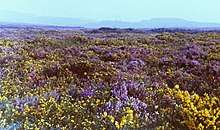
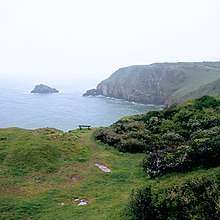

Devon straddles a peninsula and so, uniquely among English counties, has two separate coastlines: on the Bristol Channel and Celtic Sea in the north, and on the English Channel in the south.[27] The South West Coast Path runs along the entire length of both, around 65% of which is named as Heritage Coast. Before the changes to English counties in 1974, Devon was the third largest county by area and the largest of the counties not divided into county-like divisions (only Yorkshire and Lincolnshire were larger and both were sub-divided into ridings or parts, respectively).[28] Since 1974 the county is ranked fourth by area (due to the creation of Cumbria) amongst ceremonial counties and is the third largest non-metropolitan county. The island of Lundy and the reef of Eddystone are also in Devon. The county has more mileage of road than any other county in England.
Inland, the Dartmoor National Park lies wholly in Devon, and the Exmoor National Park lies in both Devon and Somerset. Apart from these areas of high moorland the county has attractive rolling rural scenery and villages with thatched cob cottages. All these features make Devon a popular holiday destination.
In South Devon the landscape consists of rolling hills dotted with small towns, such as Dartmouth, Ivybridge, Kingsbridge, Salcombe, and Totnes. The towns of Torquay and Paignton are the principal seaside resorts on the south coast. East Devon has the first seaside resort to be developed in the county, Exmouth and the more upmarket Georgian town of Sidmouth, headquarters of the East Devon District Council. Exmouth marks the western end of the Jurassic Coast World Heritage Site. Another notable feature is the coastal railway line between Newton Abbot and the Exe Estuary: the red sandstone cliffs and sea views are very dramatic and in the resorts railway line and beaches are very near.
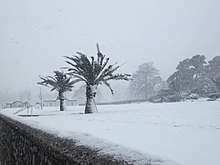
North Devon is very rural with few major towns except Barnstaple, Great Torrington, Bideford and Ilfracombe. Devon's Exmoor coast has the highest cliffs in southern Britain, culminating in the Great Hangman, a 318 m (1,043 ft) "hog's-back" hill with an 250 m (820 ft) cliff-face, located near Combe Martin Bay.[29] Its sister cliff is the 218 m (715 ft) Little Hangman, which marks the western edge of coastal Exmoor. One of the features of the North Devon coast is that Bideford Bay and the Hartland Point peninsula are both west-facing, Atlantic facing coastlines; so that a combination of an off-shore (east) wind and an Atlantic swell produce excellent surfing conditions. The beaches of Bideford Bay (Woolacombe, Saunton, Westward Ho! and Croyde), along with parts of North Cornwall and South Wales, are the main centres of surfing in Britain.
Geology
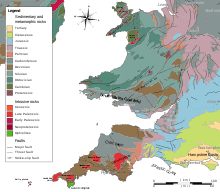
A geological dividing line cuts across Devon roughly along the line of the Bristol to Exeter line and the M5 motorway east of Tiverton and Exeter. It is a part of the Tees-Exe line broadly dividing Britain into a southeastern lowland zone typified by gently dipping sedimentary rocks and a northwestern upland zone typified by igneous rocks and folded sedimentary and metamorphic rocks.
The principal geological components of Devon are the Devonian (in north Devon, south west Devon and extending into Cornwall); the Culm Measures (north western Devon also extending into north Cornwall); and the granite intrusion of Dartmoor in central Devon, part of the Cornubian batholith forming the 'spine' of the southwestern peninsula. There are small remains of pre-Devonian rocks on the south Devon coast.[30]
The oldest rocks which can be dated are those of the Devonian period which are approximately 395–345 million years old. Sandstones and shales were deposited in North and South Devon beneath tropical seas. In shallower waters, limestone beds were laid down in the area now near Torquay and Plymouth.[31] This geological period was named after Devon by Roderick Murchison and Adam Sedgwick in the 1840s and is the only British county whose name is used worldwide as a geological time period.[32]
Devon's second major rock system[33] is the Culm Measures, a geological formation of the Carboniferous period that occurs principally in Devon and Cornwall. The measures are so called either from the occasional presence of a soft, sooty coal, which is known in Devon as culm, or from the contortions commonly found in the beds.[34] This formation stretches from Bideford to Bude in Cornwall, and contributes to a gentler, greener, more rounded landscape. It is also found on the western, north and eastern borders of Dartmoor.
The sedimentary rocks in more eastern parts of the county include Permian and Triassic sandstones (giving rise to east Devon's well known fertile red soils); Bunter pebble beds around Budleigh Salterton and Woodbury Common and Jurassic rocks in the easternmost parts of Devon. Smaller outcrops of younger rocks also exist, such as Cretaceous chalk cliffs at Beer Head and gravels on Haldon, plus Eocene and Oligocene ball clay and lignite deposits in the Bovey Basin, formed around 50 million years ago under tropical forest conditions.
Climate
Devon generally has a cool oceanic climate, heavily influenced by the North Atlantic Drift. In winter snow is relatively uncommon away from high land, although there are exceptions. The county has mild summers with occasional warm spells and cool rainy periods. Winters are generally cool and the county often experiences some of the mildest winters in the world for its high latitude, with average daily maximum temperatures in January at 8 °C (46 °F). Rainfall varies significantly across the county, ranging from over 2,000 mm (79 in) on parts of Dartmoor, to around 750 mm (30 in) in the rain shadow along the coast in southeastern Devon and around Exeter. Sunshine amounts also vary widely: the moors are generally cloudy, but the SE coast from Salcombe to Exmouth is one of the sunniest parts of the UK (a generally cloudy region). With westerly or southwesterly winds and high pressure the area around Torbay and Teignmouth will often be warm, with long sunny spells due to shelter by high ground (Foehn wind).
| Climate data for Devon | |||||||||||||
|---|---|---|---|---|---|---|---|---|---|---|---|---|---|
| Month | Jan | Feb | Mar | Apr | May | Jun | Jul | Aug | Sep | Oct | Nov | Dec | Year |
| Average high °C (°F) | 8 (46) |
8 (46) |
10 (50) |
12 (54) |
15 (59) |
18 (64) |
19 (66) |
19 (66) |
18 (64) |
15 (59) |
11 (52) |
9 (48) |
13.5 (56.3) |
| Average low °C (°F) | 4 (39) |
4 (39) |
5 (41) |
6 (43) |
8 (46) |
11 (52) |
13 (55) |
13 (55) |
12 (54) |
9 (48) |
7 (45) |
5 (41) |
8 (46) |
Ecology
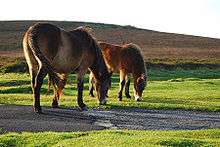
The variety of habitats means that there is a wide range of wildlife (see Dartmoor wildlife, for example). A popular challenge among birders is to find over 100 species in the county in a day. The county's wildlife is protected by several wildlife charities such as the Devon Wildlife Trust, which looks after 40 nature reserves. The Devon Bird Watching and Preservation Society (founded in 1928 and known since 2005 as "Devon Birds") is a county bird society dedicated to the study and conservation of wild birds.[35] The RSPB has reserves in the county, and Natural England is responsible for over 200 Devon Sites of Special Scientific Interest and National Nature Reserves,[36] such as Slapton Ley. The Devon Bat Group was founded in 1984 to help conserve bats. Wildlife found in this area extend to a plethora of different kinds of insects, butterflies and moths; an interesting butterfly to take look at is the Chequered skipper.
The botany of the county is very diverse and includes some rare species not found elsewhere in the British Isles other than Cornwall. Devon is divided into two Watsonian vice-counties: north and south, the boundary being an irregular line approximately across the higher part of Dartmoor and then along the canal eastwards. Botanical reports begin in the 17th century and there is a Flora Devoniensis by Jones and Kingston in 1829.[37] A general account appeared in The Victoria History of the County of Devon (1906), and a Flora of Devon was published in 1939 by Keble Martin and Fraser.[38] An Atlas of the Devon Flora by Ivimey-Cook appeared in 1984, and A New Flora of Devon, based on field work undertaken between 2005 and 2014, was published in 2016.[39]
Rising temperatures have led to Devon becoming the first place in modern Britain to cultivate olives commercially.[40]
Politics and administration
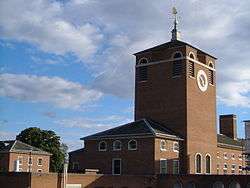
The administrative centre and capital of Devon is the city of Exeter. The largest city in Devon, Plymouth, and the conurbation of Torbay (which includes the largest town in Devon and capital of Torbay, Torquay, as well as Paignton and Brixham) have been unitary authorities since 1998, separate from the remainder of Devon which is administered by Devon County Council for the purposes of local government.
Devon County Council is controlled by the Conservatives, and the political representation of its 62 councillors are: 38 Conservatives, 9 Liberal Democrats, seven Labour, four UKIP, three Independents and one Green.[41]
At the 2019 general election, Devon returned 10 Conservatives and two Labour MPs to the House of Commons.[42]
- Hundreds
Historically Devon was divided into 32 hundreds:[43] Axminster, Bampton, Black Torrington, Braunton, Cliston, Coleridge, Colyton, Crediton, East Budleigh, Ermington, Exminster, Fremington, Halberton, Hartland, Hayridge, Haytor, Hemyock, Lifton, North Tawton and Winkleigh, Ottery, Plympton, Roborough, Shebbear, Shirwell, South Molton, Stanborough, Tavistock, Teignbridge, Tiverton, West Budleigh, Witheridge, and Wonford.
Cities, towns and villages
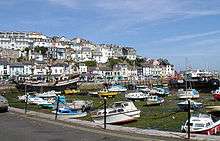
The main settlements in Devon are the cities of Plymouth, a historic port now administratively independent, Exeter, the county town, and Torbay, the county's tourist centre. Devon's coast is lined with tourist resorts, many of which grew rapidly with the arrival of the railways in the 19th century. Examples include Dawlish, Exmouth and Sidmouth on the south coast, and Ilfracombe and Lynmouth on the north. The Torbay conurbation of Torquay, Paignton and Brixham on the south coast is now administratively independent of the county. Rural market towns in the county include Barnstaple, Bideford, Honiton, Newton Abbot, Okehampton, Tavistock, Totnes and Tiverton.
The boundary with Cornwall has not always been on the River Tamar as at present: until the late 19th century a few parishes in the Torpoint area were in Devon and five parishes now in north-east Cornwall were in Devon until 1974. (However, for ecclesiastical purposes these were nevertheless in the Archdeaconry of Cornwall and in 1876 became part of the Diocese of Truro.)
Religion
Ancient and medieval history
The region of Devon was the dominion of the Dumnonii Celtic tribe they were also called "Deep Valley Dwellers". The region was less Romanised than the rest of Roman Britain since it was considered a remote province. The Romans left the region around AD 410, this is when one of the leading Dumnonii families attempted to create a dynasty and rule over Devon as the Kings of Dumnonii.[44]
Celtic paganism and Roman practices were the first known religions in Devon, although in the mid-fourth century AD, Christianity was introduced to Devon.[45] In the Sub-Roman period the church in the British Isles was characterised by some differences in practice from the Latin Christianity of the continent of Europe and is known as Celtic Christianity;[46][47][48] however it was always in communion with the wider Roman Catholic Church. Many Cornish saints are commemorated also in Devon in legends, churches and place-names. Western Christianity came to Devon when it was over a long period incorporated into the kingdom of Wessex and the jurisdiction of the bishop of Wessex. Saint Petroc is said to have passed through Devon, where ancient dedications to him are even more numerous than in Cornwall: a probable seventeen (plus Timberscombe just over the border in Somerset), compared to Cornwall's five. The position of churches bearing his name, including one within the old Roman walls of Exeter, are nearly always near the coast, reminding us that in those days travelling was done mainly by sea. The Devonian villages of Petrockstowe and Newton St Petroc are also named after Saint Petroc and the flag of Devon is dedicated to him.
The history of Christianity in the South West of England remains to some degree obscure. Parts of the historic county of Devon formed part of the diocese of Wessex, while nothing is known of the church organisation of the Celtic areas. About 703 Devon and Cornwall were included in the separate diocese of Sherborne and in 900 this was again divided into two, the Devon bishop having from 905 his seat at Tawton (now Bishop's Tawton) and from 912 at Crediton, birthplace of St Boniface. Lyfing became Bishop of Crediton in 1027 and shortly afterwards became Bishop of Cornwall.
The two dioceses of Crediton and Cornwall, covering Devon and Cornwall, were permanently united under Edward the Confessor by Lyfing's successor Bishop Leofric, hitherto Bishop of Crediton, who became first Bishop of Exeter under Edward the Confessor, which was established as his cathedral city in 1050. At first, the abbey church of St Mary and St Peter, founded by Athelstan in 932 and rebuilt in 1019, served as the cathedral.
Later history
In 1549, the Prayer Book Rebellion caused the deaths of thousands of people from Devon and Cornwall. During the English Reformation, churches in Devon officially became affiliated with the Church of England. From the late sixteenth century onwards, zealous Protestantism – or 'puritanism' – became increasingly well-entrenched in some parts of Devon, while other districts of the county remained much more conservative. These divisions would become starkly apparent during the English Civil War of 1642–46, when the county split apart along religious and cultural lines.[49] The Methodism of John Wesley proved to be very popular with the working classes in Devon in the 19th century. Methodist chapels became important social centres, with male voice choirs and other church-affiliated groups playing a central role in the social lives of working class Devonians. Methodism still plays a large part in the religious life of Devon today, although the county has shared in the post-World War II decline in British religious feeling.
The Diocese of Exeter remains the Anglican diocese including the whole of Devon. The Roman Catholic Diocese of Plymouth was established in the mid 19th century.[50]
Symbols
Coat of arms
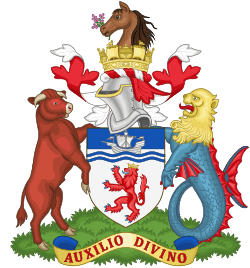
There was no established coat of arms for the county until 1926: the arms of the City of Exeter were often used to represent Devon, for instance in the badge of the Devonshire Regiment. During the forming of a county council by the Local Government Act 1888 adoption of a common seal was required. The seal contained three shields depicting the arms of Exeter along with those of the first chairman and vice-chairman of the council (Lord Clinton and the Earl of Morley).[51]
On 11 October 1926, the county council received a grant of arms from the College of Arms. The main part of the shield displays a red crowned lion on a silver field, the arms of Richard Plantagenet, Earl of Cornwall. The chief or upper portion of the shield depicts an ancient ship on wavers, for Devon's seafaring traditions. The Latin motto adopted was Auxilio Divino (by Divine aid), that of Sir Francis Drake. The 1926 grant was of arms alone. On 6 March 1962 a further grant of crest and supporters was obtained. The crest is the head of a Dartmoor Pony rising from a "Naval Crown". This distinctive form of crown is formed from the sails and sterns of ships, and is associated with the Royal Navy. The supporters are a Devon bull and a sea lion.[52][53]
Devon County Council adopted a "ship silhouette" logo after the 1974 reorganisation, adapted from the ship emblem on the coat of arms, but following the loss in 1998 of Plymouth and Torbay re-adopted the coat of arms. In April 2006 the council unveiled a new logo which was to be used in most everyday applications, though the coat of arms will continue to be used for "various civic purposes".[54][55]
Flag
Devon also has its own flag which has been dedicated to Saint Petroc, a local saint with dedications throughout Devon and neighbouring counties. The flag was adopted in 2003 after a competition run by BBC Radio Devon.[56] The winning design was created by website contributor Ryan Sealey, and won 49% of the votes cast. The colours of the flag are those popularly identified with Devon, for example, the colours of Exeter University, the rugby union team, and the Green and White flag flown by the first Viscount Exmouth at the Bombardment of Algiers (now on view at the Teign Valley Museum), as well as one of the county's football teams, Plymouth Argyle. On 17 October 2006, the flag was hoisted for the first time outside County Hall in Exeter to mark Local Democracy Week, receiving official recognition from the county council.[57] In 2019 Devon County Council with the support of both the Anglican and Catholic churches in Exeter and Plymouth, officially recognised Saint Boniface as the Patron Saint of Devon.[58]
Place names and customs
Devon's toponyms include many with the endings "coombe/combe" and "tor". Both 'coombe' (valley or hollow, cf. Welsh cwm, Cornish komm) and 'tor' (Old Welsh twrr and Scots Gaelic tòrr from Latin turris; 'tower' used for granite formations) are rare Celtic loanwords in English and their frequency is greatest in Devon which shares a boundary with Brittonic speaking Cornwall. Ruined medieval settlements of Dartmoor longhouses indicate that dispersed rural settlement (OE tun, now often -ton) was very similar to that found in Cornish 'tre-' settlements, however these are generally described with the local placename -(a)cott, from the Old English for homestead, cf. cottage. Saxon endings in -worthy (from Anglo-Saxon worthig) indicate larger settlements. Several 'Bere's indicate Anglo-Saxon wood groves, as 'leighs' indicate clearings.[59]
Devon has a variety of festivals and traditional practices, including the traditional orchard-visiting Wassail in Whimple every 17 January, and the carrying of flaming tar barrels in Ottery St. Mary, where people who have lived in Ottery for long enough are called upon to celebrate Bonfire Night by running through the village (and the gathered crowds) with flaming barrels on their backs.[60] Berry Pomeroy still celebrates "Queen's Day" for Elizabeth I.
Education
Devon has a mostly comprehensive education system. There are 37 state and 23 independent secondary schools. There are three tertiary (FE) colleges and an agricultural college (Bicton College, near Budleigh Salterton). Torbay has 8 state (with 3 grammar schools) and 3 independent secondary schools, and Plymouth has 17 state (with 3 grammar schools – two female and one male) and one independent school, Plymouth College. East Devon and Teignbridge have the largest school populations, with West Devon the smallest (with only two schools). Only one school in Exeter, Mid Devon, Torridge and North Devon have a sixth form – the schools in other districts mostly have sixth forms, with all schools in West Devon and East Devon having a sixth form.
Two universities are located in Devon, the University of Exeter (split between the Streatham Campus and St Luke's Campus, both in Exeter, and a campus in Cornwall); in Plymouth the University of Plymouth in Britain is present, along with the University of St Mark & St John to the city's north. The universities of Exeter and Plymouth have together formed the Peninsula College of Medicine and Dentistry which has bases in Exeter and Plymouth. There is also Schumacher College.
Cuisine
The county has given its name to a number of culinary specialities. The Devonshire cream tea, involving scones, jam and clotted cream, is thought to have originated in Devon (though claims have also been made for neighbouring counties); in other countries, such as Australia and New Zealand, it is known as a "Devonshire tea".[61][62][63] In Australia, Devon is a name for luncheon meat (processed ham). It has also been claimed that the pasty originated in Devon rather than Cornwall.[64]
In October 2008, Devon was awarded Fairtrade County status by the Fairtrade Foundation.
Sport
Devon has been home to a number of customs, such as its own form of Devon wrestling, similar in some ways to Cornish wrestling. As recently as the 19th century, a crowd of 17,000 at Devonport, near Plymouth, attended a match between the champions of Devon and Cornwall. Another Devon sport was outhurling which was played in some regions until the 20th century (e.g. 1922, at Great Torrington). Other ancient customs which survive include Dartmoor step dancing, and "Crying The Neck".
Devon has three professional football teams, based in each of its most populous towns and cities. As of the 2018–2019 football season, both Plymouth Argyle F.C. and Exeter City F.C. compete in English Football League Two (the fourth tier), whilst Torquay United F.C. compete in the National League (the fifth tier). Plymouth's highest Football League finish was fourth in the Second Division, which was achieved twice, in 1932 and 1953. Torquay and Exeter have never progressed beyond the third tier of the league; Torquay finished second on goal average in the Third Division (S) behind Sir Alf Ramsey's Ipswich Town in 1957. Exeter's highest position has been eighth in the Third Division (S). The county's biggest non-league clubs are Bideford F.C. which competes in the Southern Football League Premier Division, and Tiverton Town F.C. which is in the Southern Football League Division One South and West.
Rugby Union is popular in Devon with over forty clubs under the banner of the Devon Rugby Football Union, many with various teams at senior, youth and junior levels. One club – Exeter Chiefs play in the Aviva Premiership, winning the title in 2017 for the first time in their history after beating Wasps RFC in the final 23–20. Plymouth Albion who are, as of 2017, in the National League 1 (The 3rd tier of English Professional Rugby Union.
There are five rugby league teams in Devon. Plymouth Titans, Exeter Centurions, Devon Sharks from Torquay, North Devon Raiders from Barnstaple and East Devon Eagles from Exmouth. They all play in the Rugby League Conference.
In basketball, Plymouth Raiders play in the British Basketball League. Tamar Valley Cannons, also based in Plymouth, are Devon's only other representatives in the National Leagues. Motorcycle speedway is also supported in the county, with both the Exeter Falcons and Plymouth Devils succeeding in the National Leagues in recent years.
The University of Exeter Hockey Club enter teams in both the Men's and Women's England Hockey Leagues.
Horse Racing is also popular in the county, with two National Hunt racecourses (Exeter and Newton Abbot), and numerous point to point courses. There are also many successful professional racehorse trainers based in Devon.
The county is represented in cricket by Devon County Cricket Club, who play at a Minor counties level.
Devonians
Notable people
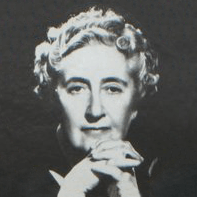
Devon is known for its mariners, such as Sir Francis Drake, Sir Humphrey Gilbert, Sir Richard Grenville, Sir Walter Raleigh, and Sir Francis Chichester. Henry Every, described as the most notorious pirate of the late 17th century, was probably born in the village of Newton Ferrers.[65] John Oxenham (1536–1580) was a lieutenant of Drake but considered a pirate by the Spanish. Thomas Morton (1576–1647) was an avid Elizabethan outdoorsman probably born in Devon who became an attorney for The Council For New England, and built the New England fur-trading-plantation called Ma-Re Mount or Merrymount around a West Country-style Maypole, much to the displeasure of Pilgrim and Puritan colonists. Morton wrote a 1637 book New English Canaan about his experiences, partly in verse, and may have thereby become America's first poet to write in English.[66] Another famous mariner and Devonian was Robert Falcon Scott, the leader of the unfortunate Terra Nova Expedition to reach the geographical South Pole.[67] The poet Samuel Taylor Coleridge, the crime writer Agatha Christie, the Irish writer William Trevor, and the poet Ted Hughes lived in Devon. The painter and founder of the Royal Academy, Sir Joshua Reynolds, was born in Devon. Chris Dawson, the billionaire owner of retailer The Range was born in Devon, where his business retains its head office in Plymouth.
.jpg)
The actor Matthew Goode was raised in Devon, and Bradley James, also an actor, was born there. The singer Joss Stone was brought up in Devon and frontman Chris Martin from the British rock group Coldplay was born there. Matt Bellamy, Dominic Howard and Chris Wolstenholme from the English group Muse all grew up in Devon and formed the band there. Dave Hill of rock band Slade was born in Flete House which is in the South Hams district of Devon. Singer-songwriter Ben Howard grew up in Totnes, a small town in Devon. Another famous Devonian is the model and actress Rosie Huntington-Whiteley, who was born in Plymouth and raised in Tavistock. The singer and songwriter Rebecca Newman was born and raised in Exmouth.[68] Roger Deakins, called "the pre-eminent cinematographer of our time", was born and lives in Devon.[69]
.jpg)
Trevor Francis, former Nottingham Forest and Birmingham City professional footballer, and the first English footballer to cost £1 million, was born and brought up in Plymouth.[70]
Swimmer Sharron Davies[71] and diver Tom Daley were born in Plymouth. The Olympic runner Jo Pavey was born in Honiton. Peter Cook the satirist, writer and comedian was born in Torquay, Devon. Leicester Tigers and British and Irish Lions Rugby player Julian White was born and raised in Devon and now farms a herd of pedigree South Devon beef cattle. The dog breeder John "Jack" Russell was also from Devon. Jane McGrath, who married Australian cricketer Glenn McGrath was born in Paignton, her long battle with and subsequent death from breast cancer inspired the formation of the McGrath Foundation, which is one of Australia's leading charities.
Devon has also been represented in the House of Commons by notable MPs such as Nancy Astor, Gwyneth Dunwoody, Michael Foot and David Owen.
See also
- List of Lord Lieutenants of Devon
- List of High Sheriffs of Devon
- Healthcare in Devon
- Custos Rotulorum of Devon – Keepers of the Rolls
- List of MPs for Devon constituency
- Category:Rivers of Devon
- Devonshire eggs
- List of hills of Devon
- List of monastic houses in Devon
- List of Sites of Special Scientific Interest in Devon
- North Devon Coast
- West Country English
- Circular linhay
- Devon Sinfonia
Notes
- Data is collected by local authority areas (Devon, Plymouth, Torbay respectively). Total population of Devon is 1,133,742 (746,399 + 256,384 + 130,959). Total population of White British persons is 1,071,015 (708,590 + 238,263 + 124,162). Percentage of White British persons is 94.467%.[3]
References
- "Lord-Lieutenant for Devon: David Fursdon - Press releases". GOV.UK. 26 March 2015. Archived from the original on 8 March 2016. Retrieved 13 November 2016.
- "No. 62943". The London Gazette. 13 March 2020. p. 5161.
- "2011 Census: Ethnic group, local authorities in England and Wales". Office for National Statistics. Archived from the original on 11 May 2017. Retrieved 27 July 2018.
- "Devon | county, England, United Kingdom". Encyclopedia Britannica. Archived from the original on 23 August 2017. Retrieved 4 July 2017.
- "Devon County Council Geographic areas". Devon County Council. Archived from the original on 22 August 2012. Retrieved 12 December 2012.
- "Welcome to the Dartmoor National Park Authority". Naturalengland.org.uk. Archived from the original on 6 September 2011. Retrieved 13 November 2016.
- "William Camden, Britannia (1607) with an English translation by Philemon Holland – Danmonii". The University of Birmingham. Archived from the original on 16 March 2009. Retrieved 30 June 2009.
- "Manuscript A: The Parker Chronicle". Archived from the original on 26 July 2011. Retrieved 17 October 2016.
- Davies, Norman (2000). The Isles: A History. p. 207. ISBN 0-333-69283-7.
- "Who do you think you really are? A genetic map of the British Isles - University of Oxford". Archived from the original on 17 February 2017. Retrieved 13 November 2016.
- "Who do you think you really are? The first fine-scale genetic map of the British Isles". wellcome.ac.uk. Archived from the original on 21 March 2015. Retrieved 19 March 2015.
- jobs. "UK mapped out by genetic ancestry : Nature News & Comment". Nature.com. Archived from the original on 10 November 2016. Retrieved 13 November 2016.
- "Lydford Silver Pennies In The Stockholm Coin Museum". Lydford.co.uk. Archived from the original on 5 March 2016. Retrieved 13 November 2016.
- Heale, M. (2016). The Abbots and Priors of Late Medieval and Reformation England. Oxford: Oxford University Press. p. 260. ISBN 978-0-19870-253-5.CS1 maint: ref=harv (link)
- "Devon's Mining History and Stannary parliament". users.senet.com.au. Archived from the original on 11 May 2008. Retrieved 29 March 2008.
- In Devon, the county council estimated that 1,200 jobs would be lost in agriculture and ancillary rural industries – Hansard, 25 April 2001 Archived 4 April 2017 at the Wayback Machine
- "Devon dairy farmer laments 'grim' state of industry as milk price crisis worsens". The Mid Devon Gazette. 14 January 2015. Retrieved 18 July 2016.
- "Devon Delivers". Invest Devon. Archived from the original on 23 December 2016. Retrieved 13 November 2016.
- "Archived copy" (PDF). Archived from the original (PDF) on 16 December 2014. Retrieved 12 December 2014.CS1 maint: archived copy as title (link)
- "Archived copy" (PDF). Archived from the original (PDF) on 26 March 2009. Retrieved 18 June 2009.CS1 maint: archived copy as title (link)
- Key Statistics: Population; Quick Statistics: Economic indicators Archived 11 February 2003 at the Wayback Machine. (2011 census and 2001 census) Retrieved 27 February 2015.
- Harris, Nigel (2008). "Taking trains back to Tavistock". Rail. Bauer (590): 40–45.
- West of Exeter Route Resillience Study, Network Rail, 2014 https://cdn.networkrail.co.uk/wp-content/uploads/2019/05/West-of-Exeter-Route-Resilience-Study-1.pdf
- "Dawlish Sea Wall". Network Rail. Retrieved 3 June 2020.
- "Archived copy" (PDF). Archived from the original (PDF) on 3 March 2016. Retrieved 25 April 2015.CS1 maint: archived copy as title (link)
- "Flights & Holidays". Exeter Airport. Retrieved 10 September 2019.
- Dewey, Henry (1948) British Regional Geology: South West England, 2nd ed. London: H.M.S.O.
- Whitaker's Almanack, 1972; p. 631
- "Archived copy". Archived from the original on 24 July 2008. Retrieved 1 August 2009.CS1 maint: archived copy as title (link)
- Edmonds, E. A., et al. (1975) South-West England; based on previous editions by H. Dewey (British Geological Survey UK Regional Geology Guide series no. 17, 4th ed.) London: HMSO ISBN 0-11-880713-7
- Hesketh, Robert (2006). Devon's Geology: An Introduction. Bossiney Books. ISBN 978-1-899-383-89-4.
- Laming, Deryck; Roche, David. "Devon Geology Guide – Devonian Slates, Sandstones and Volcanics" (PDF). Archived from the original (PDF) on 10 November 2013. Retrieved 14 May 2014.
- "Devon's Rocks – A Geological Guide". Devon County Council. Archived from the original on 3 March 2016. Retrieved 18 May 2011.
- Edmonds, E. A.; McKeown, M. C.; Williams, M. (1975). "Carboniferous Rocks". South-West England. British Geology. Dewey, H. (4th ed.). London: HMSO/British Geological Survey. p. 34. ISBN 0-11-880713-7.
- "The Society – Introduction". Devon Birds. Archived from the original on 21 December 2016. Retrieved 15 December 2016.
- "Designated sites view (Devon)". Natural England. Archived from the original on 20 December 2016. Retrieved 15 December 2016.
- Jones, John Pike & Kingston, J. F. (1829) Flora Devoniensis. 2 pts, in 1 vol. London: Longman, Rees, Orme, Brown, and Green
- Martin, W. Keble & Fraser, G. T. (eds.) (1939) Flora of Devon. Arbroath
- Smith, R.; Hodgson, B.; Ison, J. (2016). A New Flora of Devon. Exeter: The Devonshire Association. p. 1. ISBN 978-1-5272-0525-3.
- Paul Simons (14 May 2007). "Britain warms to the taste for home-grown olives". The Times. UK. Archived from the original on 6 July 2008. Retrieved 20 September 2007.
- "Tories take over county council". The BBC. 5 June 2009. Archived from the original on 8 June 2009. Retrieved 6 June 2009.
- "General Election 2019: Reaction and results from Devon and Cornwall". BBC News. Retrieved 13 December 2019.
- "Devon Hundreds". Genuki.cs.ncl.ac.uk. 23 June 2013. Archived from the original on 27 April 2016. Retrieved 13 November 2016.
- "Britannia History: Overview of Devon". www.britannia.com. Archived from the original on 3 February 2018. Retrieved 4 July 2017.
- "Devon Libraries: Sources for Anglo-Saxon Devon" (PDF). Archived from the original (PDF) on 2 February 2017.
- Bowen, E. G. (1977) Saints, Seaways and Settlements in the Celtic Lands. Cardiff: University of Wales Press ISBN 0-900768-30-4
- "St. Patrick and Celtic Christianity: Did You Know?". Christian History | Learn the History of Christianity & the Church. Archived from the original on 12 June 2017. Retrieved 4 July 2017.
- "Monasticism - The Heart of Celtic Christianity - Northumbria Community". Northumbria Community. Archived from the original on 17 January 2017. Retrieved 4 July 2017.
- Stoyle, Mark (1994). Loyalty and Locality: Popular Allegiance in Devon during the English Civil War. Exeter: University of Exeter Press. p. passim. ISBN 0-85989-428-2.
- "Home". Plymouth-diocese.org.uk. 15 February 2015. Archived from the original on 21 October 2016. Retrieved 13 November 2016.
- Fox-Davies, A. C. (1915) The Book of Public Arms, 2nd edition, London
- W. C. Scott-Giles, Civic Heraldry of England and Wales, 2nd edition, London, 1953
- "A brief history of Devon's coat of arms (Devon County Council)". Devon.gov.uk. Archived from the original on 11 May 2011. Retrieved 14 June 2010.
- "Council's designs cause logo row". BBC News. 27 March 2006. Archived from the original on 12 May 2011. Retrieved 14 June 2010.
- "Policy and Resources Overview Scrutiny Committee Minutes, 3 April 2006". Devon.gov.uk. Archived from the original on 11 May 2011. Retrieved 14 June 2010.
- "Flag celebrates Devon's heritage". BBC. 18 July 2003. Archived from the original on 25 April 2010. Retrieved 14 June 2010.
- Devon County Council Press Release, 16 October 2006 Archived 14 October 2008 at the Wayback Machine
- [http://www.creditoncourier.co.uk/article.cfm?id=138406&headline=St%20Boniface%20of%20Crediton%20to%20become%20Patron%20Saint%20of%20Devon§ionIs=news&searchyear=2019 |date=24 May 2019 }}
- "Origins of Devon Place-Names". Genuki.cs.ncl.ac.uk. 2 November 2014. Archived from the original on 14 November 2016. Retrieved 13 November 2016.
- "Ottery Tar Barrels". BBC. Archived from the original on 19 May 2008. Retrieved 14 May 2008.
- Mason, Laura; Brown, Catherine (1999) From Bath Chaps to Bara Brith. Totnes: Prospect Books
- Pettigrew, Jane (2004) Afternoon Tea. Andover: Jarrold
- Fitzgibbon, Theodora (1972) A Taste of England: the West Country. London: J. M. Dent
- BBC News, "Devon invented the Cornish pasty", 13 November 2006. Retrieved 27 January 2020
- Marley, David F. (2010). Pirates of the Americas. Santa Barbara, CA: ABC-CLIO. p. 589. ISBN 978-1-59884-201-2.
- New English Canaan or New Canaan. Containing an abstract of New England, composed in three bookes. The first booke setting forth the originall of the natives, their manners and customes, together with their tractable nature and love towards the English. The second booke setting forth the naturall indowments of the country, and what staple commodities it yealdeth. The third booke setting forth, what people are planted there, their prosperity, what remarkable accidents have happened since the first planting of it, together with their tenents and practise of their church. Written by Thomas Morton of Cliffords Inne gent, upon tenne yeares knowledge and experiment of the country. Amsterdam: Jacob Stam
- H. G. R. King, 'Scott, Robert Falcon (1868–1912)', Oxford Dictionary of National Biography, Oxford University Press, 2004; online edn, January 2011 accessed 21 June 2011
- "'Rising star' returns to Exmouth to support RNLI". 23 October 2012. Retrieved 13 November 2016.
- "Cinematographer Roger Deakins Takes Visceral Approach To His Craft". Variety. 4 October 2017. Archived from the original on 11 December 2017. Retrieved 20 December 2017.
- Briggs, Simon (9 February 2009). "The day Trevor Francis broke football's £1m mark". The Telegraph. Archived from the original on 6 March 2015. Retrieved 29 September 2014.
- "New centre to honour Plymouth Olympian Sharron Davies". Plymouth City Council. 14 March 2007. Archived from the original on 30 March 2007. Retrieved 31 August 2008.
Further reading
- Oliver, George (1846) Monasticon Dioecesis Exoniensis: being a collection of records and instruments illustrating the ancient conventual, collegiate, and eleemosynary foundations, in the Counties of Cornwall and Devon, with historical notices, and a supplement, comprising a list of the dedications of churches in the Diocese, an amended edition of the taxation of Pope Nicholas, and an abstract of the Chantry Rolls [with supplement and index]. Exeter: P. A. Hannaford, 1846, 1854, 1889
- Pevsner, N. (1952) North Devon and South Devon (Buildings of England). 2 vols. Penguin Books
- Stabb, John Some Old Devon Churches: their rood screens, pulpits, fonts, etc.. 3 vols. London: Simpkin, Marshall, Hamilton, Kent, 1908, 1911, 1916
- Stoyle, Mark (1994) Loyalty and Locality: Popular Allegiance in Devon during the English Civil War. Exeter: University of Exeter Press
External links
| Wikimedia Commons has media related to: |
| Wikivoyage has a travel guide for Devon. |
| Wikisource has the text of the Encyclopaedia Britannica (9th ed.) article Devonshire. |
- Devon County Council
- BBC Devon
- Genuki Devon Historical, geographical and genealogical information
- The Devonshire Association, a Devon-centric equivalent of the British Association
- Devon at Curlie
- Images of Devon at the English Heritage Archive




